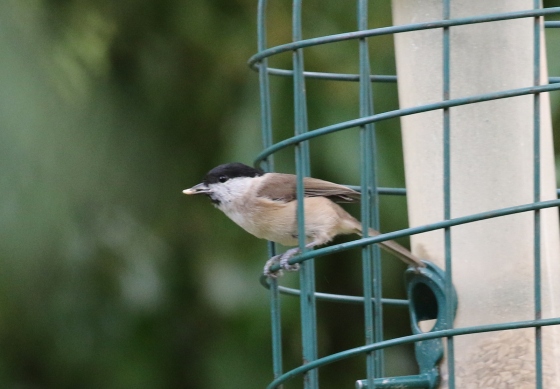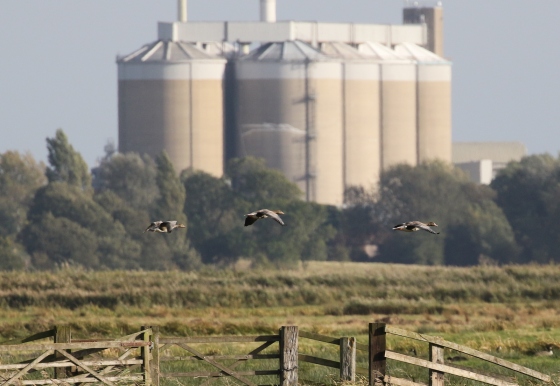Day 2/4 Marcus Nash Norfolk Trip.
Into the Brecks and the Broads
The main highlights today are listed below:-
Perhaps the most pertinent detail relates to the weather, with very strong winds prevailing which made for some very difficult birding.
- bird of the day was undoubtedly the Stone Curlew with at least 14 sightings on the pig farms just south of Swaffham.
- 2 Pectoral Sandpipers showed well at Buckenham Marshes.
- check Marcus' report for a partially-failed twitch on a housing estate in Norwich. Thankfully it was of a Rose-coloured Starling and I had already seen one in the spring at Dungeness.
- a Yellow-legged Gull at the Swaffham site was a new addition to my year list.
- I saw my first White-fronted Geese of the autumn at Buckenham Marshes.
A full report from Marcus is shown below.
12th Oct 2018 – Four Autumn Days, Day 2by The Bird ID Company |
Day 2 of a four-day Autumn Tour today. It was rather cloudy all day and very breezy again, but at least it stayed dry. With birds we wanted to try to see in the Brecks and down in the Broads, we decided to venture further afield today.
Our first target for the day was Stone Curlew. At the end of the summer, they gather together in big post breeding flocks in the Brecks. Numbers typically peak in September and start to decline in October as birds move off for the winter, but we figured we should still be able to find some of them here.
As we drove down the road, we could see several birds in the field the other side of the hedge and a glance over confirmed that there was a mixture of Stone Curlews and Lapwings. Unfortunately there is nowhere to stop here, so we continued on to try another site, in the knowledge that we could always come back if need be.
Stopping at a gate overlooking a large area of open fields, we quickly located two Stone Curlews. They were some distance over and facing away from us, into the wind, sheltering behind a line of green vegetation. Still it was a good start and we had a look at them through the scopes, so we could make out their staring yellow irises and short, black-tipped yellow bills.

As we stood here watching the Stone Curlew, several small flocks of Song Thrushes, Redwings and Skylarks flew over our heads. As we had seen yesterday, birds were on the move again today - with their migration visible even down here in the Brecks.
With Stone Curlew in the bag, we decided to have a go and see if we could find a closer one. We drove over to another field they have been favouring this autumn. The weedy vegetation here has grown up in recent weeks and there are more places to hide, but it didn't take long to find another Stone Curlew, this one much closer than the two we had seen earlier. We edged along the path beside the field so as not to disturb it, to where we could set up all the scopes and admire it.
While everyone had a good look at this Stone Curlew in the scope, we scanned the vegetation more carefully. On each sweep, we located another one hiding in the weeds until we had found at least four Stone Curlews here. Looking out to the bare stony ground beyond, we spotted another four Stone Curlews hiding up against a small ridge of earth.

After getting great views of the Stone Curlews, we decided to scan the pig fields nearby. In the first field, several Egyptian Geese were walking around the pig troughs in the middle. A Stock Dove flew in and dropped down out of view with the Woodpigeons in the middle.
At the second set of pig fields, we could see a very large flock of gulls asleep in the middle. They were almost entirely Lesser Black-backed Gulls, along with a few Black-headed Gulls and a single Common Gull. Scanning through them more carefully, we could see a larger gull asleep, half hidden in with the Lesser Black-backed Gulls. It had a paler mantle, a bit too dark for a Herring Gull, and through the scope we could see its comparatively plain white head, with just a few pencil streaks, When it opened its eye, it had a pale iris and a noticeable reddish orbital ring. It was an adult Yellow-legged Gull.

It felt like it was brightening up and for a second we could feel a bit of the sun's warmth in the air. Combined with the brisk wind, we thought it might be a good day to try to see a Goshawk up enjoying the breeze. On our way round, we stopped briefly to look at a flock of Chaffinches in some small bushes by the road and found two Bramblings in with them.
By the time we got round to a high spot overlooking the forest, the warmth in the air had disappeared again and it was back to cold, grey and windy. As we got out of the car, it was clear there was very little aerial activity over the trees and it didn't help that there was a pheasant shoot under way a couple of fields over which was very noisy and causing a lot of disturbance, with vehicles and dogs along the edge of the trees.
A Mistle Thrush flew across over the edge of the trees in front of us, and two unseasonal House Martins circled over - most of them have already left, off to Africa for the winter. We stood and watched for a few minutes and a few Common Buzzards circled up over the trees but never gained much height. A Sparrowhawk shot across, skimming above the treetops. We had a lot of ground we wanted to cover today, so we decided to move on and get away from the noise!
There has been a Rose-coloured Starling lingering on a housing estate on the outskirts of Norwich for the last few days, so on our way across to the Broads, we decided to call in for a quick look. It turned out it had been hiding in the back garden of one of the houses today, not visible from outside, but the homeowner was very kindly letting people in for a quick look whenever it appeared on the lawn. Unfortunately, it was only coming down to feed every 20-30 minutes and then only lingering there very briefly.
When we arrived, there were already several people waiting. Not long afterwards, the Rose-coloured Starling reappeared down on the lawn, the front door opened and everyone rushed in for a look. Unfortunately, due to the viewing angle, only the first few people inside could see the lawn where the bird was feeding. Only half the group got a quick look at the Rose-coloured Starling, before it flew up and disappeared into the hedge again.
We filed back outside and waited to see if there might be another showing, but it looked like the homeowner had taken a break for lunch and was no longer keeping an eye on the garden, so we decided to head on elsewhere instead.

It wasn't too far from here to Strumpshaw Fen, where we stopped for our lunch on the picnic tables by Reception Hide. The front of the pool was packed with ducks, mostly Gadwall which we stopped to admire, along with a few Mallard and a couple of Teal. The resident feral Black Swan eventually appeared with the Mute Swans, before swimming over to the front and climbing out onto the bank to preen. A couple of Marsh Harriers circled over the reeds beyond.
A steady stream of Blue Tits and Great Tits were coming in to the feeders. A sharper call alerted us to a Marsh Tit which shot in, grabbed a sunflower seed and flew over to an elder bush nearby to eat it. It came in several times over lunch, at one point joined by a second Marsh Tit, giving us a chance to get a good look at them. A Siskin flew over calling too.

After lunch, we headed round to Buckenham Marshes. As we drove down the road, a Red Kite was hanging over one of the fields and was we crossed the railway line, two more appeared over the grazing marsh right in front of us.

Scanning from the gate, we could see a few geese out on the grazing marsh and through the scopes we could see there were several groups of Canada Geese and Pink-footed Geese, along with a smaller number of Greylags. There had been a report of White-fronted Geese here this morning, but we couldn't see them at first.
As we walked down the track towards the river, we could hear them calling and looked across to see a family of three White-fronted Geese out on the grass. They were presumably just returned here for the winter, as they were calling regularly and very mobile, flying round between the different patches of marsh. Through the scope we could see there were two adults, with white surrounding the base of their bills and black bars on their grey bellied, and a juvenile which lacked those.

These were the first White-fronted Geese we have seen this autumn, and should be the first of many to return to the marshes here, where a few hundred normally spend the winter.
A flock of Barnacle Geese flew in next, circling round over the marshes before dropping down to feed with the Canada Geese. These are feral birds, which also spend the winter here. Despite their non-wild origins, they are still beautiful geese, so we did have an admiring look at them through the scopes.

While we were watching the geese, a Common Snipe flew up from the edge of the ditch in front of us and zig-zagged off away over the marshes. There were a couple of Chinese Water Deer out in the grass too.
Continuing on along the track, we stopped to scan the pools over towards the river bank. There were lots of ducks here, mainly Wigeon and Teal, along with a few Shoveler. This is a very important site for wintering Wigeon, but there are still a lot yet to return here from their Russian breeding grounds.
We had really come here to look for waders, and in particular two Pectoral Sandpipers which have been on the pools here for the last few days. We could see a little group of Ruff, including a winter satellite male with a striking white head, and several Dunlin. Through the scopes, it didn't take long to find first one and then the second of the Pectoral Sandpipers, feeding on the mud along the edge of the vegetation just behind the water.

We had a good look at the Pectoral Sandpipers from the gate on the edge of the marshes. It was a bit windy out here, but we could see they were both juveniles, with neatly pale-fringed dark feathers in the upperparts. We could see there distinctive streaked breasts, sharply demarcated against their white bellies in a neat pectoral band. They were abot the same size as the Dunlin, but with shorted bills. There were several more Common Snipe feeding on the edge of the vegetation near them too.
Continuing on to the river bank, we had another quick look at the Pectoral Sandpipers from the shelter of the hide. It was a bit further away, but out of the wind. Then it was time to head back, with a long drive ahead of us.
No comments:
Post a Comment
Note: only a member of this blog may post a comment.